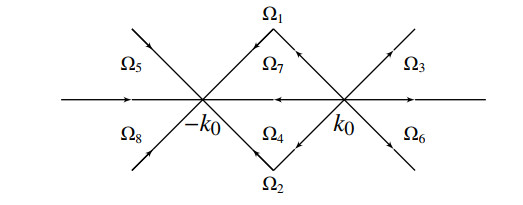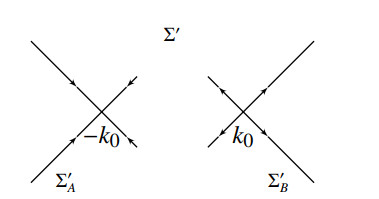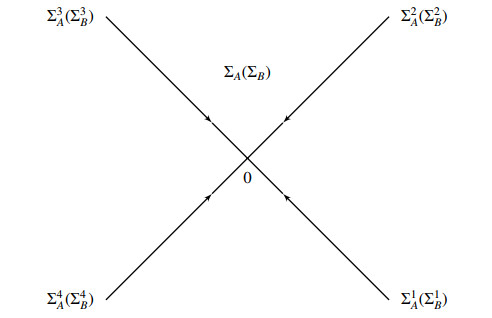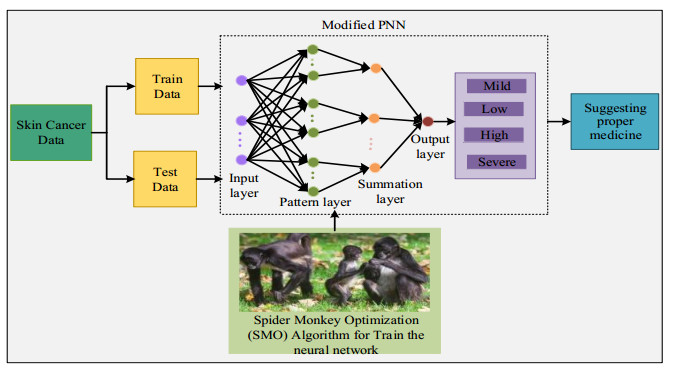1.
Introduction
The Sasa-Satsuma equation
so-called high-order nonlinear Schrödinger equation [1], is relevant to several physical phenomena, for example, in optical fibers [2,3], in deep water waves [4] and generally in dispersive nonlinear media [5]. Because this equation describes these important nonlinear phenomena, it has received considerable attention and extensive research. The Sasa-Satsuma equation has been discussed by means of various approaches such as the inverse scattering transform [1], the Riemann-Hilbert method [6], the Hirota bilinear method [7], the Darboux transformation [8], and others [9,10,11]. The initial-boundary value problem for the Sasa-Satsuma equation on a finite interval was studied by the Fokas method [12], which is also effective for the initial-boundary value problems on the half-line [35,36,37]. In Ref. [13], finite genus solutions of the coupled Sasa-Satsuma hierarchy are obtained in the basis of the theory of trigonal curves, the Baker-Akhiezer function and the meromorphic functions [14,15,16]. In Ref. [17], the super Sasa-Satsuma hierarchy associated with the 3×3 matrix spectral problem was proposed, and its bi-Hamiltonian structures were derived with the aid of the super trace identity.
The nonlinear steepest descent method [18], also called Deift-Zhou method, for oscillatory Riemann-Hilbert problems is a powerful tool to study the long-time asymptotic behavior of the solution for the soliton equation, by which the long-time asymptotic behaviors for a number of integrable nonlinear evolution equations associated with 2×2 matrix spectral problems have been obtained, for example, the mKdV equation, the KdV equation, the sine-Gordon equation, the modified nonlinear Schrödinger equation, the Camassa-Holm equation, the derivative nonlinear Schrödinger equation and so on [19,20,21,22,23,24,25,26,27,28,29,30]. However, there is little literature on the long-time asymptotic behavior of solutions for integrable nonlinear evolution equations associated with 3×3 matrix spectral problems [31,32,33]. Usually, it is difficult and complicated for the 3×3 case. Recently, the nonlinear steepest descent method was successfully generalized to derive the long-time asymptotics of the initial value problems for the coupled nonlinear Schrödinger equation and the Sasa-Satsuma equation with the complex potentials [33,34]. The main differences between the 2×2 and 3×3 cases is that the former corresponds to a scalar Riemann-Hilbert problem, while the latter corresponds to a matrix Riemann-Hilbert problem. In general, the solution of the matrix Riemann-Hilbert problem can not be given in explicit form, but the scalar Riemann-Hilbert problem can be solved by the Plemelj formula.
The main aim of this paper is to study the long-time asymptotics of the Cauchy problem for the generalized Sasa-Satsuma equation [38] via nonlinear steepest decent method,
where a is a real constant, b is a complex constant that satisfies a2≠|b|2, the asterisk "∗" denotes the complex conjugate. It is easy to see that the generalized Sasa-Satsuma equation (1.2) can be reduced to the Sasa-Satsuma equation (1.1) when a=−1 and b=0. Suppose that the initial value u0(x) lies in Schwartz space S(R)={f(x)∈C∞(R):supx∈R|xα∂βf(x)|<∞,∀α,β∈N}. The vector function γ(k) is determined by the initial data in (2.15) and (2.19), and γ(k) satisfies the conditions (P1) and (P2), where
with
(P2): When detB1>0 and a>0, (2a−|B1γ(k)|2) and (2a−detB1|γ(k)|2)/(1−γ†(k)B1γ(k)) are positive and bounded; otherwise, (|B1γ(k)|2−2a) and (detB1|γ(k)|2−2a)/(1−γ†(k)B1γ(k)) are positive and bounded.
The main result of this paper is as following:
Theorem 1.1. Let u(x,t) be the solution of the Cauchy problem for the generalized Sasa-Satsuma equation (1.2) with the initial value u0∈S(R). Suppose that the vector function γ(k) is defined in (2.19), the hypotheses (P1) and (P2) hold. Then, for x<0 and √−xt<C,
where C is a fixed constant, and
c(⋅) is rapidly decreasing, Γ(⋅) is the Gamma function, γ1 and γ2 are the first and the second row of γ(k), respectively.
Remark 1.1. The two conditions (P1) and (P2) satisfied by γ(k) are necessary. The condition (P1) guarantees the existence and the uniqueness of the solutions of the basic Riemann-Hilbert problem (2.16) and the Riemann-Hilbert problem (3.1). The boundedness of the function δ(k) defined in subsection 3.1 relies on the condition (P2).
Remark 1.2. In the case of a=−1 and b=0, the generalized Sasa-Satsuma equation (1.2) can be reduced to the Sasa-Satsuma equation. Then it is obvious that the condition (P1) is true, and the condition (P2) is reduced to the case that |γ(k)| is bounded. Therefore, the conditions (P1) and (P2) in this case are equivalent to the condition related to the reflection coefficient in [34], that is, |γ(k)| is bounded for the Sasa-Satsuma equation.
The outline of this paper is as follows. In section 2, we derive a Riemann-Hilbert problem from the scattering relation. The solution of the generalized Sasa-Satsuma equation is changed into the solution of the Riemann-Hilbert problem. In section 3, we deal with the Riemann-Hilbert problem via nonlinear steepest decent method, from which the long-time asymptotics in Theorem 1.1 is obtained at the end.
2.
Basic Riemann-Hilbert problem
We begin with the 3×3 Lax pair of the generalized Sasa-Satsuma equation
where ψ is a matrix function and k is the spectral parameter, σ=diag(1,1,−1),
We introduce a new eigenfunction μ through μ=ψe−ikσx−4ik3σt, where eσ=diag(e,e,e−1). Then (2.1a) and (2.1b) become
where [⋅,⋅] is the commutator, [σ,μ]=σμ−μσ. From (2.4a), the matrix Jost solution μ± satisfy the Volterra integral equations
Set μ±L represent the first two columns of μ±, and μ±R denote the third column, i.e., μ±=(μ±L,μ±R). Furthermore, we can infer that μ+R and μ−L are analytic in the lower complex k-plane C−, μ+L and μ−R are analytic in the the upper complex k-plane C+. Then we can introduce sectionally analytic function P1(k) and P2(k) by
One can find that U is traceless from (2.2), so detμ± are independent of x. Besides, detμ±=1 according to the evolution of detμ± at x=±∞. Because all the μ±eikσx+4ik3σt satisfy the differential equations (2.1a) and (2.1b), they are linear related. So there exists a scattering matrix s(k) that satisfies
In this paper, we denote a 3×3 matrix A by the block form
where A11 is a 2×2 matrix and A22 is scalar. Let q=(u,u∗)T and we can rewrite U of (2.2) as
where "†" is the Hermitian conjugate. In addition, there are two symmetry properties for U,
where B and τ are represented as block forms. Hence, the Jost solutions μ± and the scattering matrix s(k) also have the corresponding symmetry properties
We write s(k) as block form (sij)2×2 and from the symmetry properties (2.10) we have
where adjX denote the adjoint of matrix X. Then we can write s(k) as
where
From the evaluation of (2.6) at t=0, one infers
which implies that
Theorem 2.1. Let M(k;x,t) be analytic for k∈C∖R and satisfy the Riemann-Hilbert problem
where
γ(k) lies in Schwartz space and satisfies
Then the solution of this Riemann-Hilbert problem exists and is unique, the function
and u(x,t) is the solution of the generalized Sasa-Satsuma equation.
Proof. The matrix (J(k;x,t)+J†(k;x,t))/2 is positive definite because of the condition (P1) that γ(k) satisfies, then the solution of the Riemann-Hilbert problem (2.16) is existent and unique according to the Vanishing Lemma [39]. We define M(k;x,t) by
Considering the scattering relation (2.6) and the construction of M(k;x,t), we can obtain the jump condition and the corresponding Riemann-Hilbert problem (2.16) after tedious but straightforward algebraic manipulations. Substituting the large k asymptotic expansion of M(k;x,t) into (2.4a) and compare the coefficients of O(1k), we can get (2.21).
3.
Long-time asymptotic behavior
In this section, we compute the Riemann-Hilbert problem (2.16) by the nonlinear steepest decent method and study the long-time asymptotic behavior of the solution. We make the following basic notations. (i) For any matrix M define |M|=(trM†M)12 and for any matrix function A(⋅) define ‖A(⋅)‖p=‖|A(⋅)|‖p. (ii) For two quantities A and B define A≲B if there exists a constant C>0 such that |A|⩽CB. If C depends on the parameter α we shall say that A≲αB. (iii) For any oriented contour Σ, we say that the left side is + and the right side is −.
3.1. The first transformation: reorientation
First of all, it is noteworthy that there are two stationary points ±k0, where ±k0=±√−x12t satisfied dθdk|k=±k0=0. The jump matrix J(k;x,t) have a lower-upper triangular factorization and a upper-lower triangular factorization. We can introduce an appropriate Rieman-Hilbert problem to unify these two forms of factorizations. In this process, we have to reorient the contour of the Riemann-Hilbert problem.
The two factorizations of the jump matrix J are
We introduce a 2×2 matrix function δ(k) to make the two factorization unified, and δ(k) satisfies the following Riemann-Hilbert problem
which implies a scalar Riemann-Hilbert problem
The jump matrix I−γ(k)γ†(k∗)B1 of Riemann-Hilbert problem (3.1) is positive definite, so the solution δ(k) exists and is unique. The scalar Riemann-Hilbert problem (3.2) can be solved by the Plemelj formula,
where
Then we have by uniqueness that
Substituting (3.4) to (3.1), we have
which means that
Actually, the condition (P2) satisfied by γ(k) guarantee the boundedness of δ±(k) and we give a brief proof below. When detB1>0, we find that the Hermitian matrix B1 can be decomposition. In other words, there exists a triangular matrix S that satisfies B1=aS†S. So tr[δ†+B1δ+]=a|Sδ+|2. When detB1<0 and |a|>0, the matrix B1 has a decomposition B1=S†DS, where S is a triangular matrix and D is a diagonal matrix and the diagonal elements have opposite signs. In the case of a>0, B1 can be decomposed as below,
We denote Sδ+(k) by (Gij)3×3 and c1=2a−|B1γ(k)|2 is negative, then
Noticing that detB1<0, we find a negative constant c2 that satisfies c2⩽adetB1(c3−1)/(1−detB1c3), where c3 is a constant and 0<c3<1, which impies
The case that a<0 is similar. In particular, when a=0, then |b|>0, it is easy to see that B1 is not definite. For |Reb|>0, we have the decomposition
For |Reb|=0, we have
So we get the boundedness of |δ+(k)|. The others have the same analysis,
Hence, by the maximum principle, we have
for all k∈C. We define the functions
We reverse the orientation for k∈(−∞,k0)∪(k0,+∞) as in Figure 1, and MΔ(k;x,t)=M(k;x,t)Δ−1(k) satisfies the Riemann-Hilbert problem on the reoriented contour
where the jump matrix JΔ(k;x,t) has a decomposition
3.2. Extend to the augmented contour
For the convenience of discussion, we define
Theorem 3.1. The vector function ρ(k) has a decomposition
where R(k) is a piecewise-rational function and h2(k) has a analytic continuation to L. Besides, they admit the following estimates
for an arbitrary positive integer l. Considering the Schwartz conjugate
we can obtain the same estimate for e2itθ(k)h†1(k∗), e2itθ(k)h†2(k∗) and e2itθ(k)R†(k∗) on R∪L∗.
Proof. It follows from Proposition 4.2 in [18].
A direct calculation shows that b± of (3.20) can be decomposed further
Define the oriented contour Σ by Σ=L∪L∗ as in Figure 2. Let
Lemma 3.1. M♯(k;x,t) is the solution of the Riemann-Hilbert problem
where the jump matrix J♯(k;x,t) satisfies
Proof. We can construct the Riemann-Hilbert problem (3.25) based on the Riemann-Hilbert problem (3.19) and the decomposition of b±. In the meantime, the asymptotics of M♯(k;x,t) is derived from the convergence of b± as k→∞. For fixed x and t, we pay attention to the domain Ω3. Noticing the boundedness of δ(k) and detδ(k) in (3.16), we arrive at
Consider the definition of R(k) in this domain,
where m is a positive integer and μi is the coefficient of the Taylor series around k0. Combining with the boundedness of h2(k) in Theorem 3.1, we obtain that M♯(k;x,t)→I when k∈Ω3 and k→∞. The others are similar to this domain.
The above Riemann-Hilbert problem (3.25) can be solved as follows. Set
Let
denote the Cauchy operator, where C+f (C−f) denotes the left (right) boundary value for the oriented contour Σ in Figure 2. Define the operator Cω♯:L2(Σ)+L∞(Σ)→L2(Σ) by
for the 3×3 matrix function f.
Lemma 3.2 (Beals-Coifman). If μ♯(k;x,t)∈L2(Σ)+L∞(Σ) is the solution of the singular integral equation
Then
is the solution of the Riemann-Hilbert problem (3.25).
Proof. See [18], P. 322 and [40].
Theorem 3.2. The expression of the solution q(x,t) can be written as
Proof. From (2.21), (3.24) and Lemma 2, the solution q(x,t) of the generalized Sasa-Satsuma equation is expressed by
3.3. Contour truncation
Set Σ′=Σ∖(R∪Lϵ∪L∗ϵ) oriented as in Figure 3. We will convert the Riemann-Hilbert problem on the contour Σ to a Riemann-Hilbert problem on the contour Σ′ and estimate the errors between the two Riemann-Hilbert problems. Let ω♯=ωe+ω′=ωa+ωb+ωc+ω′, where ωa=ω♯|R is supported on R and is composed of terms of type h1(k) and h†1(k∗); ωb is supported on L∪L∗ and is composed of contribution to ω♯ from terms of type h2(k) and h†2(k∗); ωc is supported on Lϵ∪L∗ϵ and is composed of contribution to ω♯ from terms of type R(k) and R†(k∗).
Lemma 3.3. For arbitrary positive integer l, as t→∞,
Proof. The proof of estimates (3.30), (3.31), (3.32) follows from Theorem 3.1. Afterwards, we consider the definition of R(k) on the contour {k=k0+αk0e−3πi4|−∞<α<ϵ},
Resorting to Re(iθ)⩾8α2k30 and the boundedness of δ(k) and detδ(k) in (3.16), we can obtain
Then we obtain (3.33) by simple computations.
Lemma 3.4. As t→∞, (1−Cω′)−1:L2(Σ)→L2(Σ) exists and is uniformly bounded:
Furthermore, ‖(1−Cω♯)−1‖L2(Σ)≲1.
Proof. It follows from Proposition 2.23 and Corollary 2.25 in [18].
Lemma 3.5. As t→∞,
Proof. A simple computation shows that
After a series of tedious computations and utilizing the consequence of Lemma 4, we arrive at
Then the proof is accomplished as long as we substitute the estimates above into (3.35).
Notice that ω′(k)=0 when k∈Σ∖Σ′, let Cω′|L2(Σ′) denote the restriction of Cω′ to L2(Σ′). For simplicity, we write Cω′|L2(Σ′) as Cω′. Then
Lemma 3.6. As t→∞,
Proof. From (3.29) and (3.34), we can obtain the result directly.
Let L′=L∖Lϵ and μ′=(1−Cω′)−1I. Then
solves the Riemann-Hilbert problem
where
3.4. Noninteraction of disconnected contour components
Let the contour Σ′=Σ′A∪Σ′B and ω′±=ω′A±+ω′B±, where
Define the operators Cω′A and Cω′B: L2(Σ′)+L∞(Σ′)→L2(Σ′) as in definition (3.28).
Lemma 3.7.
Proof. See Lemma 3.5 in [18].
Lemma 3.8. As t→∞,
Proof. From identity
we have
Based on Lemma (3.7) and Lemma (3.4), we arrive at (3.38).
For the sake of convenience, we write the restriction Cω′A∣L2(Σ′A) as Cω′A, similar for Cω′B. From the consequences of Lemma 3.6 and Lemma 3.8, as t→∞, we have
3.5. Rescaling and further reduction of the Riemann-Hilbert problems
Extend the contours Σ′A and Σ′B to the contours
respectively. We introduce ˆω′A and ˆω′B on ˆΣ′A and ˆΣ′B, respectively, by
Let ΣA and \Sigma_{B} denote the contours \{k = k_{0}\alpha e^{\pm\frac{\pi i}{4}}:\alpha\in\mathbb{R}\} oriented inward as in \Sigma^{\prime}_{A} , \hat{\Sigma}^{\prime}_{A} , and outward as in \Sigma^{\prime}_{B} , \hat{\Sigma}^{\prime}_{B} , respectively. Define the scaling operators
and set
A simple change-of-variable arguments shows that
where the operator C_{\omega_{A}}\ (C_{\omega_{B}}) is a bounded map from \mathscr{L}^{2}(\Sigma_{A})\ (\mathscr{L}^{2}(\Sigma_{B})) into \mathscr{L}^{2}(\Sigma_{A})\ (\mathscr{L}^{2}(\Sigma_{B})) . On the part
of \Sigma_{A} , we have
on L^{\ast}_{A} we have
where
Lemma 3.9. As t\rightarrow\infty , and k\in L_{A} , then
where \tilde{\delta}(k) = e^{-2it\theta(k)}[\delta(k)R(k)-(\mathrm{det}\delta(k))R(k)] .
Proof. It follows from (3.1) and (3.2) that \tilde{\delta} satisfies the following Riemann-Hilbert problem:
where f(k) = \delta_{-}(k)[\gamma^\dagger(k^\ast)B_1\gamma(k)I-\gamma(k)\gamma^\dagger(k^\ast)B_1]R(k) . The solution for the above Riemann-Hilbert problem can be expressed by
Observing that
we obtain f(k) = O((k^{2}-k^{2}_{0})^{l}). Similar to the Lemma 3.1, f(k) can be decomposed into two parts: f(k) = f_{1}(k)+f_{2}(k) , and
where f_{2}(k) has an analytic continuation to L_{t} , l is a positive integer and l\geqslant2 ,
(see Figure 5).
As k\in L_{A} , we obtain
As a consequence of Cauchy's Theorem, we can evaluate I_{3} along the contour L_{t} instead of the interval (\frac{k_{0}}{t}-k_{0}, k_{0}) and obtain \left|I_{3}\right|\lesssim t^{-l+1}. Therefore, (3.45) holds.
Corollary 3.1. As t\rightarrow\infty , and k\in L_{A}^\ast , then
where \hat{\delta}(k) = e^{2it\theta(k)}R^{\dagger}(k^{\ast})B_1[\delta^{-1}(k)-(\mathrm{det}\delta(k))^{-1}I] .
Let J^{A^0} = (I-\omega_{A^0-})^{-1}(I+\omega_{A^0+}) , where
It follows from (3.78) in [18] that
There are similar consequences for k\in\Sigma_B . Let J^{B^0} = (I-\omega_{B^0-})^{-1}(I+\omega_{B^0+}) , where
Theorem 3.3. As t\to\infty ,
Proof. Notice that
Utilizing the triangle inequality and the boundedness in (3.53), we have
According to (3.5) and a simple change-of-variable argument, we have
There are similar computations for the other case. Together with (3.39), one can obtain (3.57).
For k\in\mathbb{C}\backslash\Sigma_A , set
Then M^{A^0}(k; x, t) is the solution of the Riemann-Hilbert problem
In particular
then
There is a analogous Riemann-Hilbert problem on \Sigma_{B} ,
where J^{B^0}(k; x, t) is defined in (3.54) and (3.56). In the meantime, we have
Next, we consider the relation between M^{A^0}_1 and M^{B^0}_1 . From the expression (3.50), (3.52), (3.54) and (3.56), we have the symmetry relation
By the uniqueness of the Riemann-Hilbert problem,
Combining with the expansion (3.60) and (3.63), one can verify that
Therefore, from (3.57) and (3.61), we have
3.6. Solving the model problem
In this subsection, we compute (M_1^{A^0})_{12} explicitly. It is important to set
Then it follows from (3.59) that
The jump matrix is the constant one on the four rays \Sigma_A^1 , \Sigma_A^2 , \Sigma_A^3 , \Sigma_A^4 , so
Then it follows that (\mathrm{d}\Psi/\mathrm{d}k+ik\sigma\Psi)\Psi^{-1} has no jump discontinuity along any of the four rays. Besides, from the relation between \Psi(k) and H(k) , we have
It follows by the Liouville's Theorem that
where
Moreover,
Set
From (3.68) and its differential, we obtain
As is well known, the Weber's equation
has the solution
where D_{\varrho}(\cdot) denotes the standard parabolic-cylinder function, and c_1 , c_2 are constants. The parabolic-cylinder function satisfies [41]
As \zeta\rightarrow\infty , from [42], we have
where \Gamma(\cdot) is the Gamma function. Set \varrho = i\beta_{21}\beta_{12} ,
where a_1, a_2, a_3, a_4 are constants. As \arg{k}\in(-\pi, -\frac{3\pi}{4})\cup(\frac{3\pi}{4}, \pi) and k\rightarrow\infty , we arrive at
then
Consequently,
For \arg{k}\in(-\frac{3\pi}{4}, -\frac{\pi}{4}) and k\rightarrow\infty , we have
then
Consequently,
Along the ray \arg k = -\frac{3\pi}{4},
Notice the (2, 1) entry of the Riemann-Hilbert problem,
It follows from (3.71) that
Then we separate the coefficients of the two independent functions and obtain
Noting that B^{-1}(J^{A^0}(k^\ast))^\dagger B = (J^{A^0}(k))^{-1} , we have \beta_{12} = -B_1^{-1}\beta_{21}^\dagger , which means that
Finally, we can obtain (1.4) from (3.64), (3.69) and (3.77).
Acknowledgments
This work is supported by the National Natural Science Foundation of China (Grant Nos. 11871440 and 11931017).
Conflict of interest
The authors declare no conflict of interest.










 DownLoad:
DownLoad:






















